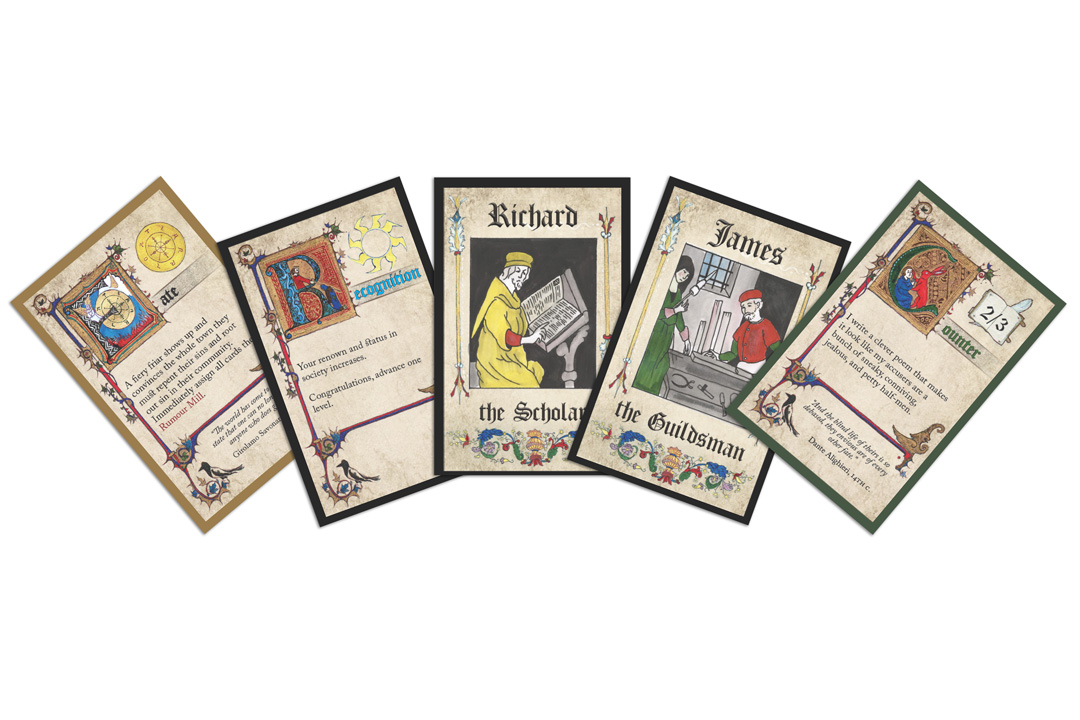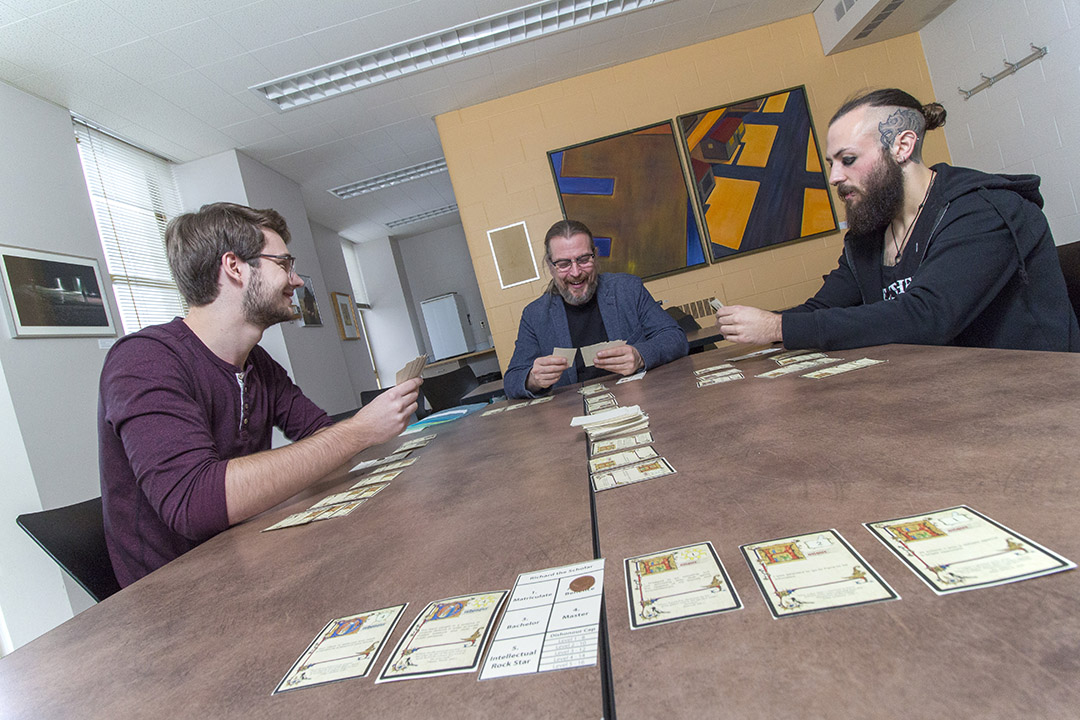
A new board game designed to teach the old rules of masculinity
Some years ago, my senior class on medieval masculinity was discussing an article by historian Barbara Hanawalt about men and poaching in medieval England. We were focusing on Hanawalt’s analysis of a medieval poem, “The Parlement of the Thre Ages” that includes a description of poaching a deer, slaughtering it and quickly hiding the remains. At the back of the class an otherwise quiet student was shaking his head.
By Frank KlaassenWhen I asked him what he was thinking, he told me that he came from three generations of conservation officers and that he believed Hanawalt got most things absolutely right. The poachers and officers drink in the same bars. They know each other on a first-name basis. They compete with each other in a kind of game. But he went on to say that he believed Hanawalt had misunderstood the description of dressing a deer in the bush. It did not celebrate the experience as sensuous as she had suggested. Instead, the poem celebrated the hunter’s skill with a knife and the great value of a five-point buck which is still a trophy animal today.
It was clear he was right. But you needed to know hunting to be able to make sense of it.
I filed this experience away and still recount it as one of those occasions in teaching when a student has taught me, when they brought aspects of their lives to bear on the study of a distant past.
Another aspect of Hanawalt’s article was important. It drew on the work of Dutch historian, Johan Huizinga, who described poaching as a “game” because it included the elements of fun, sport, a playing field, players and rules. It was potentially a deadly game, but also included high-status prizes like a five-point buck or the ability to provide venison for banquets.
All of this got me thinking about the power of games, masculinity as a kind of game, and how important personal experience is to understanding and learning.
Last year all these pieces fell into place. I decided to make game-development a class project in my senior history seminar on medieval masculinity. We would take what we learned from readings, the students’ individual research papers and our discussions and use them to create a game that modelled the medieval “game” of male honour. The idea was to create something that would teach others about the medieval world both through factual content and also through “played” experience.
Developing the game

I’ve always been proud of my students at the University of Saskatchewan. But they really outdid themselves on this piece. The final product was breathtaking in sophistication, content and appearance. There is no way I could have produced this on my own.
Every part of the cards were carefully considered. The cards mimic medieval manuscripts, the figures in the historiated initials illustrate the function of the cards, the various men in the game are represented as they would have been in medieval art, the scenarios are either realistic or drawn from real historical events and almost every card is accompanied by a quotation from pre-modern literature.
We dubbed the game Virtus which can loosely be translated as “manliness.”
Read more about Virtus: Medieval manliness: USask students design board game in history class.
What the game tells us about masculinity
Virtus teaches its players through visual elements, quotations and stories or scenarios. It includes scores of real events such as the case of a cross-dressing male prostitute in Oxford, using necromantic magic to hunt for treasure or the in flagrante killing of an unfaithful wife and her lover in Italy. But the game also teaches broader ideas about medieval masculinity.
The game illustrates how medieval concepts of gender were in some ways more fluid than our own. Clerics, for example, could be regarded as a third gender. They had to be sexually male but were in almost every critical respect unlike other men: they had to wear long gowns and could not show off their calves, could not bear arms or draw blood, could not marry and could not have biological children. They had to develop their own distinctive standards for honour and achievement.
Virtus illustrates the benefits men get from a patriarchal society. One of the cards reads, “Congratulations to me! I was born a man and gave honour to my family.” But masculinity also had its costs.
Fathers ruled, but they were also responsible for the behaviour of everyone in their household including the servants. If someone misbehaved, the head of the house was to blame unless he took control, properly punished the offender, and made sure it didn’t happen again. Those who didn’t were ridiculed, sometimes in public shaming rituals. In art they were represented as being beaten by a women, an image we used on the Dishonour Cards.
How the game taught us
Historians have sought to educate broader audiences through historical non-fiction, museum exhibitions, documentaries and podcasts and blogs. But we have not taken up making games as a form of public history. The fact that Virtus is fun, accessible and also good history demonstrated to us that historians could be more involved in the world of games.
Games are not only vehicles for teaching non-historians, they can also teach historians about the past. Virtus took on a life of its own, offering perspectives on the past that we had not thought about. It also prompted some interesting questions.
For example, we discovered that the mechanics of the game promoted natural alliances between clerics and laymen. They were mostly not in competition with each other for common marks of honour. This meant it was uncomplicated for them to support each other’s advancement. Suddenly the powerful alliances between bishops and kings made sense not only in political terms, but in social ones.
The game also prompted discussions about how one would create a comparable game about women. How it would be different and why. Could we have a game with the same kinds of mechanics? Definitely not. What would we call it? There is no feminine equivalent of the word “virtus” which includes the sense of “manliness, manhood, strength, vigour, bravery, courage and excellence.” And would a game about femininity be as funny? If not, why not? Finally, would modern men be as willing to play such a game as women are to play this one?
That game will probably be the next project, so I guess we’ll find out.
Virtus
For more information about the game see the Virtus Facebook page. You can also go to our History Games site where you can download and print a copy of the game, although you will have to cut the cards yourself.
The History and CMRS students involved in the development of Virtus were Kristen Forest, Nicole Hall, Emily Huel, Amani Khelifa, Benjamin Kmiech, Katherine McPhee, Jordan Nickel and Chloe Peters. Particularly notable contributions were made by Cierra Anderson, Jonah Egan-Pimblett, Jackson Hase and Alex Margarit.

